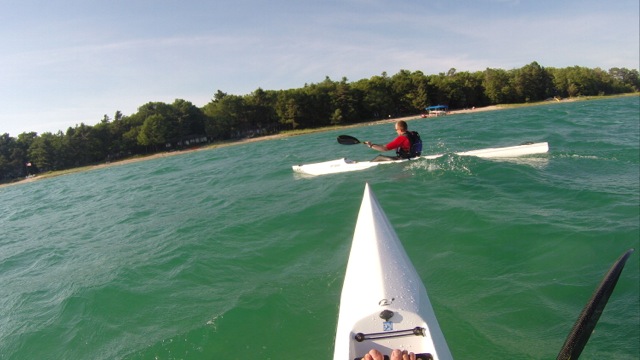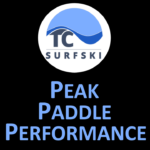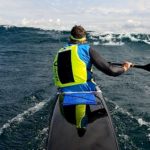Downwind Surfski Paddling – Don’t Discount Finesse
I haven’t been able to paddle that often since racing the Molokai in mid May, but luckily most of the paddling I have done has been in good wind/wave conditions. This past weekend I had the chance to take my younger brothers out for their first time in surf skis and try to teach them the art of paddling downwind and catching waves.
Working with beginners has made me realize that in the beginning, downwind paddling tends to be 10% elation and 90% frustration. Hopefully by focusing on the points below you can quickly change that ratio and get to a point of 80-90% elation. I also have a vested interest in getting newbies surfing waves ASAP. In my experience, once someone catches a few waves on a downwind paddle they are fully hooked on the sport and if they haven’t purchased a surf ski yet, it quickly becomes just a matter of time 🙂
Two absolute requirements first:
- You must be in a boat that is stable for you
- You must have a solid forward stroke with a strong catch and the ability to generate explosive power
Breaking down the components of Downwind Paddling:
I am becoming more and more convinced that you can actually break downwind paddling into 3 different phases which I have outlined below:
- One with the wave
- Riding the wave
- No man’s land
One With the Wave
This is truly the sweet spot of downwind paddling. This is where you have matched your boat exactly to the speed/direction of the wave and you and the wave have become one. At this point in time you are locked onto the wave and not really moving relative to it. Unfortunately it won’t last forever, but there are tips and tricks to make this phase last as long as possible.
How I do this: The epiphany that I had recently (after 9 years of struggling with this), is that I am actually using the wave in front of me to determine the right speed and direction to position my boat on the wave I will actually ride (a wave I never really see). How this works is that I try to “draft” the biggest wave I can see in front of me, but am very cautious of not overtaking it, ideally I want to stay 1-5 feet behind the peak of the wave, depending on the wave size. This is where some serious finesse factors into the equation. A finesse I was sorely lacking for my first 9 years of paddling.
The sequence typically goes like this:
- Wave roles underneath you and you see the peak moving away from your bow.
- You decide this one isn’t going to get away, and put in a strong and hard effort to “GET IT”.
- You actually get too excited and don’t realize that you have momentum and if you don’t back off sooner than you think, you’ll overtake the wave, plow into the trough and be right back at square one.
The critical point is this: when you start getting close to the wave you are chasing, it is critical to ease up and really feel where you’re at. If your bow is staying an equal distance from the wave peak after you’ve let up, then perfect, your in the sweet spot and on the wave behind the one you’re “drafting”, enjoy the ride. If the wave peak is gaining ground on you, then put in a couple light strokes, maybe even a half stroke to see if that does the trick. If you are gaining ground on the peak in front then you may try to put on the brakes with a brace stroke (this is tough and I certainly haven’t mastered it yet) . If you overtake the wave, most likely you’ll start to bury the nose at which point the best approach is to put in some hard strokes until you find the next wave to sneak up on.
Key note: for many years I wanted to blame burying the nose either on the waves being too short and choppy, the boat being too long, or the bow not having enough volume. I now realize none of those factors are relevant, the bow gets buried when you get stuck in the trough or overrun the wave. The reality is probably that the only time a buried bow is not the fault of the driver is in massive and steep waves.
Analogy for bikers : For all of the road bikers out there, think of what I described above as being essentially the same as drafting a bike rider. You always want to look for the biggest rider to get behind, same thing with the waves. Look for the biggest peak you can see in your field of view. You need to put in a hard effort to get behind the peak and into the draft, but as it goes with biking, you absolutely don’t want to charge too hard and crash into the back tire of the rider in front of you. Thankfully in surfski paddling the consequences are much less significant and the wave you crash into won’t take offense, but nonetheless it will be frustrating for you. Similar to road bike drafting there is a sweet spot (not too close, not too far). Of course you aren’t actually drafting the wave, but by pretending that you are, this essentially sets you up for a good ride on the wave behind the wave you’re drafting.
Riding the Wave
Unfortunately all good things must come to an end, and this is the case with the “sweet spot” ride. At a certain point the wave is fading and it is critical that you use the speed and momentum it has provided you to get to your next wave. At this point you ditch the wave and use it to slingshot you over to the next best wave that you see in front of you (remember, sweet as it may be, your bond with each wave is just a short fling, at the end of the day your are an opportunist always looking for the next best thing :-). Sometimes this is very obvious and easy and just a few powerful strokes have you right onto the next wave (or right behind the next wave – however you want to look at it). There are times when the next wave will be directly in front of you and times that it will be to your left or to your right. You need to be constantly scanning in front to determine this.
No Man’s Land
Despite your best efforts, there will be times when you come off a run and just don’t see the next one in time to leverage your momentum from the existing wave. When this happens, you have to know that the next wave will always be in front of you. Because of this, the best thing to do is just paddle hard and steady until you see a hole developing and then chase it. If you don’t paddle strong and steady you’ll quickly drop speed and the waves will be moving faster than you are and it become shard to break out of the “stuck in the trough” cycle. This is where explosive power becomes a huge advantage. If you do get caught in the trough cycle, explosive power is critical to get you out of it and chasing the next wave.
Summary
Like most great sports and athletic activities, downwind paddling on a surf ski is truly a blend and balance of not only raw power and explosion, but also finesse, timing, and restraint. I believe that it is the latter half where most of us have the opportunity to make vast improvements that will pay dividends in our performance. Not too mention boosting us into that highly addictive zone where downwind paddling is all about elation as opposed to frustration!
Below is a great video showing some of the concepts I have described above. This was a lesson that I did with two of my brothers who had never previously been in surfskis or done any considerable ocean kayaking.



